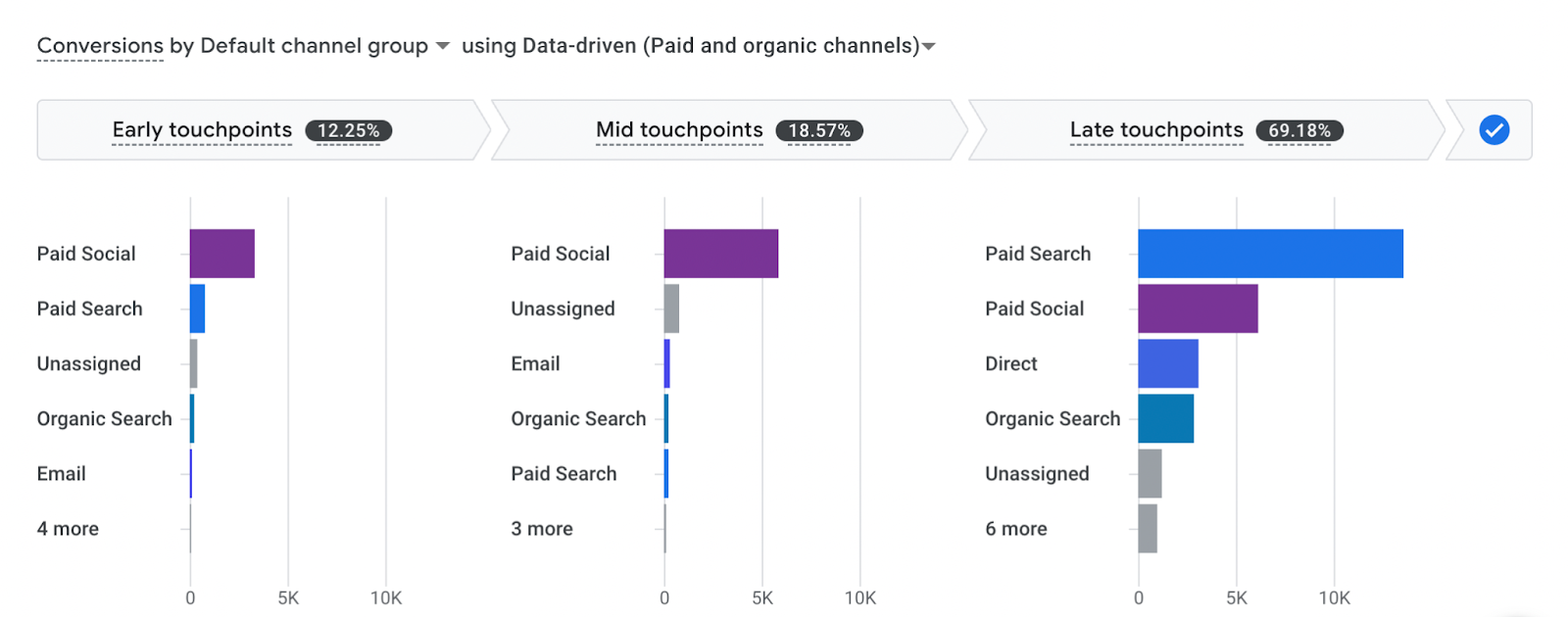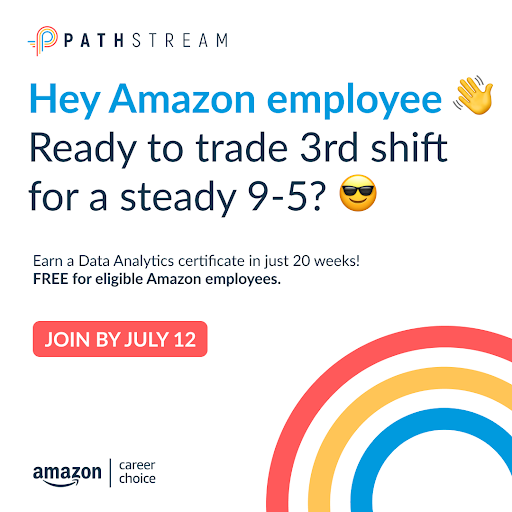Full-Funnel Tracking Through Multi-Touchpoint Attribution
What was your most recent significant purchase? Did you click Purchase immediately after learning it existed? If not, it’s probably because you needed more information before fully committing.
Maybe your shopping experience looked like this:
You saw a TikTok featuring the product, found it interesting, and visited the website to learn more.
↓
A few days later, a Facebook ad reminded you of the product. You clicked on it and provided your email to receive a discount code.
↓
Several weeks later, you received an email from the company, notifying you that your discount code was expiring.
↓
Later that day, you recalled the email, launched a Google search to find the brand associated again, and went to the website to make your purchase.
💥
Most customer journeys aren’t linear and require time. That time is why multi-touch attribution is crucial for measuring marketing effectiveness. In this example, using last-click attribution for reporting would credit Google as the sole source of your purchase, disregarding all the other touchpoints that kept you interested (TikTok, Facebook, and email).
But what if you hadn’t seen the TikTok or the Facebook ad that led you to the discount offer? What if the reminder email never came? This particular combination of touchpoints highlights the importance of considering every step in the customer journey, not just the first or last.
In this blog, we’ll uncover what makes multi-touch attribution so essential to accurate and actionable marketing reporting. From tools to user experience and optimizing for growth, we’ll explore the full spectrum of tracking marketing touchpoints and building better strategies.
Understanding full-funnel tracking in marketing
So, what is multi-touch attribution? It’s a marketing measurement that evaluates each interaction a user has with a brand. This allows marketers to assign value to every channel in the customer journey and weigh the significance of each.
Multi-touch attribution is essential for any growth marketing strategy. It provides access to full-funnel tracking, enabling analysis of which channels drive customer engagement and revenue–and to what degree. The real power lies in precision–figuring out what’s effective and what’s not. As you uncover those channels and campaigns that bring in the biggest returns on investment, you’re in control of smartly distributing your budget, making the most impact, and steering your growth strategy toward success.
Tools and techniques for effective full-funnel attribution
At Tuff, we use a variety of tools for full-funnel tracking depending on our partner and their industry. Notable multi-touch attribution tools include:
With multi-touch attribution tools like these, you can create and customize your own dashboard to gather and analyze data across all channels throughout the entire user journey.
Real-Life Example
For example, we have an Amplitude dashboard set up for our partner Pathstream, a career mobility platform. In their dashboard, we track every interaction from ad click > website visit > sign-up > program purchase.
When we dig into the dashboard data, we’re checking out a few key data points. First, we’re eyeing the click-through rate (CTR) of the ad. Then, we’re looking at how many people go from clicking to showing interest (that’s the lead conversion rate). Last stop? We’re watching the rate of people who actually enroll or make a purchase. All this info helps us see where to fine-tune the ad, the landing page, or the emails–all to pump up those conversion rates.
Examining conversions by source like the visualization above shows the impact of paid and organic channels across various stages of the customer journey. In the early touchpoints, paid channels amplify brand recognition and ignite initial interactions. Activating retargeting initiatives across social caused that spike in mid-journey touchpoints on Facebook. The huge jump in conversions during late touchpoints shows that further down the funnel, people are more likely to convert on Google, Facebook, AND direct. Altogether, we see that different platforms have power at various stages of the user journey, and using this data helps marketers decide how to spend resources wisely for growth.
Fine Tune Your Performance Creative
With Pathstream, we utilize performance creative to analyze what type of ad archetype and messaging perform best on each channel. Our goal is to drive more revenue and decrease the customer acquisition cost (CAC). With multi-touch attribution, we could see that the Facebook ad below drove the most clicks, sign-ups, and enrollments compared to any other ad we tested. Without multi-touch attribution, we would have only been able to see the clicks and sign-ups from the ad and not the CVR from sign-up to enrollment.
The power of customer journey insights
When you can thoroughly analyze every step of your conversion funnel and track the origins of your conversions, you’re empowered to make smarter marketing decisions that result in sustainable growth. For example, if TikTok has a higher CVR throughout the entire funnel in comparison to display advertising, we can reallocate the display budget and direct more funds towards TikTok to lower CAC and increase revenue.
When you have insights into the customer journey, you can also tailor your messaging across various channels based on where the user is in their journey. For instance, your Facebook ads might generate a strong CTR yet fail to convert on the website due to users needing additional product information.
With this data and insight, you can create a plan on how you’ll provide more product information to the user. One solution might be to update your landing page to include more social proof or create a blog on your website that answers commonly asked questions.
Another solution might be to add more touchpoints to the user journey so you can communicate your products’ unique value propositions. This is where retargeting strategies can prove effective. By personalizing your retargeting messages across channels, you can guide users from awareness to consideration.
Fueling growth with data-driven optimization
In a recent Pathstream campaign, we leveraged multi-touch attribution data to create a full-funnel growth marketing strategy encompassing diverse channels. These included programmatic ads, social ads, paid and organic search, conversion rate optimizations on the website, and nurture flow email campaigns.
While not every channel led to last-click conversions, we effectively gauged the impact from each channel by assessing both view-through and click-through conversions using multi-touch attribution. Beyond validating marketing channels, this approach enabled us to precisely identify optimal messaging strategies for each channel. As a result, we increased the CVR at every stage of the funnel.
By increasing the CVR, we increased the number of leads quarter over quarter by 86% and increased the enrollments quarter over quarter by 100%.
Embracing multi-touch attribution for growth
Without multi-touch attribution, it’s impossible to know the effectiveness of your marketing strategies. When you make decisions based on just part of the story, you leave out crucial bits of information that unlock truths about your customers’ experience. But with multi-touch attribution, you get access to full-funnel tracking and data-driven customer insights. This will ultimately help you build a sustainable, validated growth marketing strategy optimized to scale.
Interested in learning more about how you can create a growth marketing strategy using multi-touch attribution? Give us a shout!

Hey there! I’m McKenzie, a Growth Marketer at Tuff who lives in Nashville, TN. After years of experience working at agencies in paid media, I found my way to Tuff in 2021 to work with startups, scaleups, and established brands on full-funnel growth strategies rooted in data. When I’m not working, you can find me taking my dog Burley to the park, traveling with friends and family, or winding down at the local yoga studio. Let’s connect.







